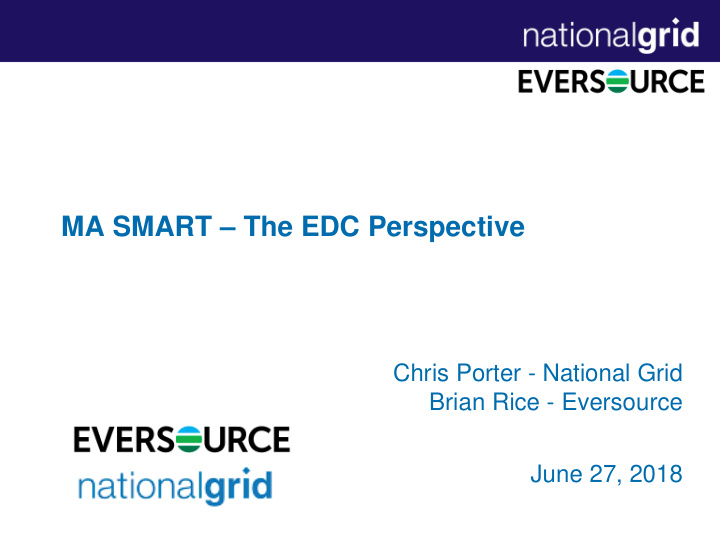



MA SMART – The EDC Perspective Chris Porter - National Grid Brian Rice - Eversource June 27, 2018 1
Disclaimer The following presentation summarizes the electric distribution companies’ proposed terms and conditions for the SMART program and tariffs, which have not yet been ruled on by the DPU as of the date of this presentation. Given the pendency of a final decision, if any person relies on any of the content of this presentation to make decisions, he or she is doing so at his or her own risk. The DPU may approve, modify, or reject any aspect of the SMART program and tariffs that are summarized here. It is the responsibility of readers and viewers of this presentation to inform themselves of the final outcome(s) of the SMART proceeding, and any eventual difference(s) from the content provided here. 2
Agenda The Interconnection Process – What’s changing, what won’t Role of the EDC – EDC interactions with program participants and the SPA MA SMART compensation – How system owners will collect value under MA SMART 3
Agenda The Interconnection Process – What’s changing, what won’t Role of the EDC – EDC interactions with program participants and the SPA MA SMART compensation – How system owners will collect value under MA SMART 4
MA SMART Overview Fundamental similarities Fundamental differences • EDC role in interconnecting PV • Responsibility for system systems production tracking • Net metering – Rules, caps, • Monetization of incentives compensation • The AOBC mechanism as a virtual net metering alternative Key change – New role for EDC’s in collecting, tracking system output, and paying output-based incentives 5
The Interconnection Process Things staying the same : EDC specific processes and tools for making, monitoring interconnection requests Interconnection timelines EDC teams supporting the interconnection process The MA SMART / SPA incentive application process is designed to complement the EDC interconnection process, not replace it 6
The Interconnection Process Things that will change : Additional applicant-paid metering charges In behind the meter situations, need for a second, utility installed meter for measuring system output behind the retail meter Will require customer-installed wiring, installation of a second meter socket Must be adequately accessible, proximate to existing utility revenue meter 7
Agenda The Interconnection Process – What’s changing, what won’t Role of the EDC – EDC interactions with program participants and the SPA MA SMART compensation – How system owners will collect value under MA SMART 8
Who you gonna call? Issue type Primary point of contact General MA SMART Program questions Program / adder eligibility questions Incentive application status / process questions Interconnection application status / process questions Incentive rate calculation questions Incentive payment questions 9
Agenda The Interconnection Process – What’s changing, what won’t Role of the EDC – EDC interactions with program participants and the SPA MA SMART compensation – How system owners will collect value under MA SMART 10
Key Distinction Behind-the-Meter Standalone System that serves on-site load other System that serves no associated on- than parasitic or station load utilized site load other than parasitic or station to operate the unit load utilized to operate the unit Behind the meter systems will be compensated differently than standalone systems 11
Behind the meter system compensation Non-SMART Compensation Rate Volume How it’s paid To whom? Net Retail net metering rate Net excess Monthly bill EDC customer during billing cycle generation credit of record metered Relevant purchased Applied to all Varies EDC customer QF power tariff rate net exports of record SMART Incentive Compensation Rate Volume How it’s paid To whom? Base compensation rate Production meter Monthly Authorized Net (net of adders / output, net of payment from payee metered subtractors) less fixed VOE parasitic load (not net EDC & QF of other on-site load) 12
Standalone system compensation Non-SMART Compensation Rate Volume How it’s paid To whom? Retail net metering rate during billing Net excess Monthly bill credit EDC customer Net cycle generation of record metered QF Relevant purchased power tariff rate Net excess Monthly payment Authorized generation from EDC payee AOBC Basic service rate in effect as of Net excess Monthly bill credit EDC billing period generation customer(s) of record SMART Incentive Compensation Rate Volume How it’s paid To whom? Net Base compensation rate (net of Net excess Monthly payment Authorized adders / subtractors) less VOE generation from EDC payee metered (relevant net metering rate) Base compensation rate (net of Net excess Monthly payment Authorized QF adders / subtractors) less VOE generation from EDC payee (relevant purchase power tariff rate) Base compensation rate (net of Net excess Monthly payment Authorized AOBC adders / subtractors) less VOE generation from EDC payee 13 (basic service rate in effect)
For additional information 2018 Distributed Generation Workshops Date Location Hosting EDC July 19 Waltham August 23 Hadley September 12 Westwood October 18 Brockton November 7 Hadley December 12 Westwood https://sites.google.com/site/massdgic/home/interconnection/workshops 14
Recommend
More recommend